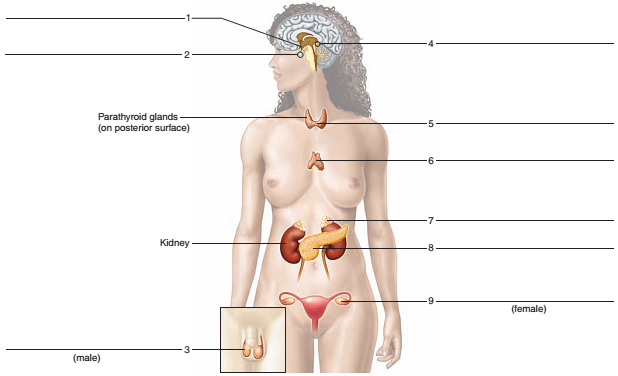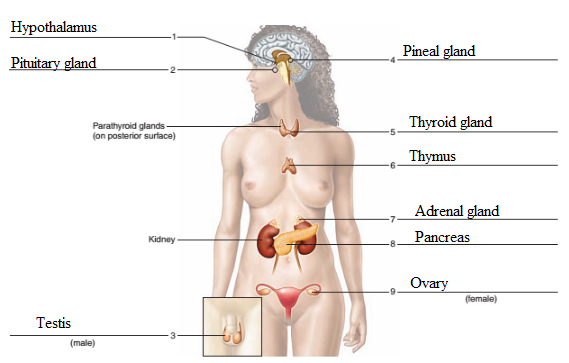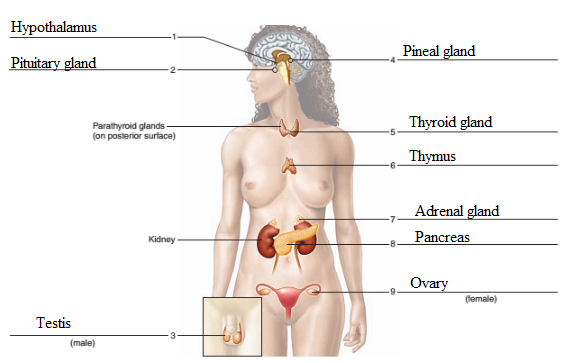

FIGURE 36.1 Label the major endocrine gladds.
To determine:
The endocrine glands in the given figure.
Introduction :
The glands of the endocrine system are termed as the endocrine glands. These glands secrete their secretions (hormones) directly into the blood, without the use of any kind of ducts. The glands included in the endocrine system are the pituitary glands, testes, ovaries, thyroid glands, parathyroid glands, adrenal glands, pineal glands, and pancreas.
Explanation of Solution
The endocrine glands in the given figure are labeled as follows:

- Hypothalamus − It is small portion of the brain that is located at the brain’s base, near the pituitary gland. Its main function is to regulate body temperature.
- Pituitary gland - Pituitary gland is present in sella turcica of sphenoid bone. This gland is also termed as the master gland as the hormones released by this gland affect the metabolism, growth, sexuality, development, and reproduction of the body.
- Testis - Testes are the paired glands and are the important male reproductive organ that produces spermatozoa and androgens.
- Pineal gland − It is an endocrine gland found in the brain. It secrets melatonin that regulates the sleep-wake cycles in humans.
- Thyroid gland - Thyroid gland is the ductless gland located in the neck region. It produces thyroxine hormone. Thyroid stimulating hormone or thyrotropic hormone is a glycoprotein that stimulates the thyroid gland to secrete thyroxine (T4) hormone and then triiodothyronine hormone (T3).
- Thymus - Thymus is located in mediastinum and thoracic cavity of neck. In adolescent, it helps in the development of immune system.
- Adrenal gland - Adrenal glands are triangular shaped glands that are present at the top of both the kidneys. The adrenal cortex is the outermost portion of this gland. The adrenal medulla is the innermost portion of the adrenal gland that secretes flight and fight hormones, epinephrine and norepinephrine.
- Pancreas - The pancreas is located at the back of the stomach and behind the stomach. It functions as an endocrine gland and as well as an exocrine gland. Many enzymes and juices are secreted by the enzymes during the digestive process. The two important enzymes of this gland are insulin and glucagon.
- Ovary − It is an organ found in the reproductive system of the females to produce ovum.
The endocrine glands in the given figure are labeled as follows:

Want to see more full solutions like this?
Chapter 36 Solutions
Laboratory Manual for Holes Human Anatomy & Physiology Fetal Pig Version
Additional Science Textbook Solutions
Physics for Scientists and Engineers
Genetics: From Genes to Genomes
Campbell Essential Biology (7th Edition)
Microbiology Fundamentals: A Clinical Approach
Human Physiology: An Integrated Approach (8th Edition)
- Ch.21 What causes patients infected with the yellow fever virus to turn yellow (jaundice)? A. low blood pressure and anemia B. excess leukocytes C. alteration of skin pigments D. liver damage in final stage of disease — What is the advantage for malarial parasites to grow and replicate in red blood cells? A. able to spread quickly B. able to avoid immune detection C. low oxygen environment for growth D. cooler area of the body for growth — Which microbe does not live part of its lifecycle outside humans? A. Toxoplasma gondii B. Cytomegalovirus C. Francisella tularensis D. Plasmodium falciparum — explain your answer thoroughlyarrow_forwardCh.22 Streptococcus pneumoniae has a capsule to protect it from killing by alveolar macrophages, which kill bacteria by… A. cytokines B. antibodies C. complement D. phagocytosis — What fact about the influenza virus allows the dramatic antigenic shift that generates novel strains? A. very large size B. enveloped C. segmented genome D. over 100 genes — explain your answer thoroughlyarrow_forwardWhat is this?arrow_forward
- Molecular Biology A-C components of the question are corresponding to attached image labeled 1. D component of the question is corresponding to attached image labeled 2. For a eukaryotic mRNA, the sequences is as follows where AUGrepresents the start codon, the yellow is the Kozak sequence and (XXX) just represents any codonfor an amino acid (no stop codons here). G-cap and polyA tail are not shown A. How long is the peptide produced?B. What is the function (a sentence) of the UAA highlighted in blue?C. If the sequence highlighted in blue were changed from UAA to UAG, how would that affecttranslation? D. (1) The sequence highlighted in yellow above is moved to a new position indicated below. Howwould that affect translation? (2) How long would be the protein produced from this new mRNA? Thank youarrow_forwardMolecular Biology Question Explain why the cell doesn’t need 61 tRNAs (one for each codon). Please help. Thank youarrow_forwardMolecular Biology You discover a disease causing mutation (indicated by the arrow) that alters splicing of its mRNA. This mutation (a base substitution in the splicing sequence) eliminates a 3’ splice site resulting in the inclusion of the second intron (I2) in the final mRNA. We are going to pretend that this intron is short having only 15 nucleotides (most introns are much longer so this is just to make things simple) with the following sequence shown below in bold. The ( ) indicate the reading frames in the exons; the included intron 2 sequences are in bold. A. Would you expected this change to be harmful? ExplainB. If you were to do gene therapy to fix this problem, briefly explain what type of gene therapy youwould use to correct this. Please help. Thank youarrow_forward
- Molecular Biology Question Please help. Thank you Explain what is meant by the term “defective virus.” Explain how a defective virus is able to replicate.arrow_forwardMolecular Biology Explain why changing the codon GGG to GGA should not be harmful. Please help . Thank youarrow_forwardStage Percent Time in Hours Interphase .60 14.4 Prophase .20 4.8 Metaphase .10 2.4 Anaphase .06 1.44 Telophase .03 .72 Cytukinesis .01 .24 Can you summarize the results in the chart and explain which phases are faster and why the slower ones are slow?arrow_forward
- Can you circle a cell in the different stages of mitosis? 1.prophase 2.metaphase 3.anaphase 4.telophase 5.cytokinesisarrow_forwardWhich microbe does not live part of its lifecycle outside humans? A. Toxoplasma gondii B. Cytomegalovirus C. Francisella tularensis D. Plasmodium falciparum explain your answer thoroughly.arrow_forwardSelect all of the following that the ablation (knockout) or ectopoic expression (gain of function) of Hox can contribute to. Another set of wings in the fruit fly, duplication of fingernails, ectopic ears in mice, excess feathers in duck/quail chimeras, and homeosis of segment 2 to jaw in Hox2a mutantsarrow_forward
 Human Biology (MindTap Course List)BiologyISBN:9781305112100Author:Cecie Starr, Beverly McMillanPublisher:Cengage Learning
Human Biology (MindTap Course List)BiologyISBN:9781305112100Author:Cecie Starr, Beverly McMillanPublisher:Cengage Learning Human Physiology: From Cells to Systems (MindTap ...BiologyISBN:9781285866932Author:Lauralee SherwoodPublisher:Cengage Learning
Human Physiology: From Cells to Systems (MindTap ...BiologyISBN:9781285866932Author:Lauralee SherwoodPublisher:Cengage Learning





